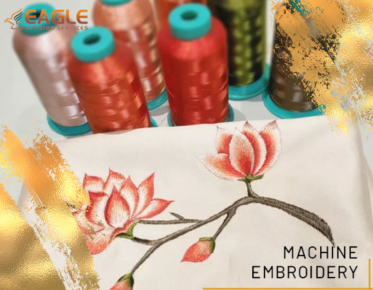Stitching a New Trend: The Rise of Digitized Embroidery on Caps and Hats
In the world of fashion,
caps and hats are more than just accessories; they are canvases for
self-expression. Digitized embroidery has emerged as a powerful technique,
transforming these everyday items into unique pieces of art. The marriage of
technology and creativity allows for intricate designs, vibrant colors, and
stunning details that capture the eye and tell a story. This exploration into
the art of digitized embroidery reveals why caps and hats are ideal for this
craft, along with essential tools and techniques to help you master the process.
Choosing the Right Equipment
Essential
Tools for Digitized Embroidery
Equipping
yourself with the right tools is crucial for success in digitized embroidery.
At the core is a high-quality embroidery machine that can handle the unique
demands of stitching on caps. Beyond the machine, you'll need digitizing
software that converts graphics into embroidery files, ensuring your designs
translate perfectly onto fabric. Additional tools like scissors, seam rippers,
and a reliable heat press can enhance your workflow and finish.
Selecting
the Perfect Embroidery Machine for Caps
When choosing an
embroidery machine, look for features that cater specifically to cap
embroidery. A machine with a cap frame allows you to hoop the caps securely,
preventing any shifting during the embroidery process. Additionally, consider
machines with multiple needleheads for efficiency and versatility. Brands like
Brother and Janome offer options tailored for both hobbyists and professionals,
making it essential to assess your needs before making a purchase.
The
Importance of Quality Threads and Stabilizers
Quality threads
and stabilizers are the unsung heroes of embroidery success. Threads should be
strong yet flexible, able to withstand the rigors of washing and wearing while
maintaining vibrant colors. Stabilizers play a pivotal role in preventing
distortion, ensuring that your embroidery retains its intended shape and
clarity. Opt for tear-away or cut-away stabilizers depending on your design’s
complexity and fabric type, as the right choice can make all the difference.
Design Considerations
Creating
Compelling Designs: What Works Best for Caps
The best designs
for caps are bold and straightforward, easily identifiable from a distance.
Consider using large, impactful graphics or text that captures attention
without overcrowding the space. Simple, well-defined shapes translate better
into embroidery, while intricate details may get lost or muddied. Remember,
your design should reflect the personality of the cap—whether it’s sporty,
trendy, or classic.
Color
Theory: Choosing the Right Palette for Your Embroidery
Color theory
plays a crucial role in embroidery design. Select a palette that complements
the cap’s color while also ensuring your design stands out. Utilize contrasting
colors to create visual interest, and consider how colors will interact with
one another when stitched. Incorporating gradients can add depth and dimension,
but keep in mind that too many colors can complicate the embroidery process.
Size
Matters: Optimal Dimensions for Embroidery on Caps
Finding the right
size for your embroidery is essential for achieving the desired impact.
Generally, designs for caps should range from 2 to 5 inches wide, depending on
the style and fit of the cap. Ensure that the scale of your design harmonizes
with the cap's shape, allowing for adequate space around the embroidery to
avoid a cluttered look. It’s always a good idea to create a digital mockup to
visualize how your design will appear on the cap before proceeding.
Preparing Your Artwork
Converting
Graphics into Embroidery Files: A Step-by-Step Guide
Transforming
graphics into embroidery files is a crucial step in the digitizing process.
Begin by selecting a suitable image or design, ensuring it’s high-resolution
for the best quality. Import your graphic into your digitizing software and use
the tools to outline and convert it into stitches. Pay attention to details
such as stitch types and densities, which will affect the final appearance.
After finalizing your design, save it in the appropriate embroidery file format
(e.g., DST, PES) for your machine.
Understanding
File Formats: What You Need to Know
Embroidery
machines require specific file formats to interpret designs accurately. Commonformats include DST, PES, and EMB, each with its own unique characteristics.
Familiarize yourself with the capabilities of your machine to ensure
compatibility. Always double-check your design before sending it to the
machine, as discrepancies in file formats can lead to unintended outcomes.
The
Role of Software in Digitizing Your Design
Digitizing
software is the heart of the embroidery process, allowing designers to
manipulate graphics into stitch-ready files. Programs like Wilcom, Hatch, and
Embird offer robust features for professional digitizing, including stitch
editing and preview capabilities. Learning to navigate these programs is
essential, as they provide the tools needed to bring your vision to life.
Investing time in mastering your software will pay off in the quality of your
final embroidery.
Stabilization Techniques
Why
Stabilizers Matter: Protecting Your Embroidery
Stabilizers are
fundamental in protecting your embroidery and ensuring its longevity. They
provide the necessary support to prevent fabric distortion during stitching,
allowing the embroidery to maintain its intended shape. Using the right
stabilizer for the fabric type can drastically improve the quality of your
work, making it crucial to understand their importance in the embroidery
process.
Types
of Stabilizers: Which One Should You Use?
Different projects
require different types of stabilizers. Tear-away stabilizers are ideal for
lightweight fabrics, providing support while allowing for easy removal
post-embroidery. Cut-away stabilizers are best for stretchy materials, offering
stability without compromising the fabric’s elasticity. Experimenting with
various stabilizers will help you determine the best fit for your projects,
enhancing the overall quality of your embroidery.
Tips
for Properly Applying Stabilizers for Caps
When preparing
caps for embroidery, properly applying stabilizers is key to achieving optimal
results. Always ensure that the stabilizer is larger than the embroidery area
to provide adequate support. Secure it in place with adhesive spray or by
hooping it together with the cap. This will help prevent shifting and puckering
during the stitching process, ensuring your design comes out crisp and clean.
Embroidery Techniques for Caps
Exploring
Different Stitch Types and Their Applications
Understanding the
various stitch types is essential for creating captivating embroidery. Satin
stitches offer a smooth finish for lettering and outlines, while fill stitches
are perfect for larger areas of color. Additionally, specialty stitches like
zigzag and running stitches can add texture and interest to your designs.
Familiarizing yourself with these techniques will enable you to select the best
stitches for your specific projects.
The
Importance of Underlay Stitches for Cap Embroidery
Underlay stitches
serve as the foundation for your embroidery, providing stability and preventing
fabric puckering. They act as a base layer that supports the top stitches,
ensuring that the design remains flat and even. Depending on the complexity of
your design, various underlay techniques can be employed, including zigzag and
edge running stitches. Incorporating underlay stitches will significantly
improve the overall quality of your embroidery.
How
to Use Appliqué for Eye-Catching Designs
Appliqué is a
fantastic technique for adding dimension and flair to your cap embroidery. By
stitching a piece of fabric onto the cap as part of your design, you can create
visually striking effects. This method allows for the incorporation of
different textures and colors, enhancing the overall aesthetic. To execute
appliqué, ensure your embroidery machine is equipped with the appropriate
settings and follow a step-by-step process to achieve a flawless finish.
Setting Up Your Machine
Preparing
Your Embroidery Machine for Cap Embroidery
Before diving
into the embroidery process, it’s vital to prepare your machine specifically
for cap embroidery. Begin by attaching the cap frame, ensuring it is secure and
aligned correctly. Check the machine settings, adjusting for the type of fabric
and design you’ll be working with. Proper preparation minimizes the chances of
errors and enhances your workflow, paving the way for a successful embroidery
session.
Thread
Tension: Finding the Perfect Balance
Thread tension is
critical in achieving high-quality embroidery. Too tight, and your stitches may
pucker; too loose, and they can unravel. Adjusting the tension is often a
matter of trial and error, but keeping the following in mind can help: the type
of thread, the fabric’s thickness, and the specific design. Testing on a scrap
piece of fabric can help you find the perfect balance before moving on to your
final cap.
Needle
Selection: Choosing the Right Size for Caps
Choosing the
right needle size is essential for cap embroidery, as it directly affects the
quality of your stitches. Typically, a 75/11 or 80/12 needle is suitable for
most cap materials, but this can vary depending on the fabric type. A sharp
needle is ideal for woven fabrics, while a ballpoint needle works best for
knits. Always ensure that your needle is appropriate for your specific project
to achieve optimal results.
The Embroidery Process
Step-by-Step
Guide to Embroidering Caps and Hats
Embarking on the
embroidery process involves several steps to ensure a successful outcome. Begin
by prepping your artwork and stabilizers, then hoop the cap securely, making
sure everything is aligned correctly. Load your embroidery design into the
machine, adjusting settings as needed. Once everything is set, start the
machine, monitoring the process closely to catch any issues early on. After
completion, carefully remove the cap from the machine and trim any excess
threads.
Common
Pitfalls to Avoid During the Embroidery Process
Embroidery can be
tricky, and certain pitfalls are best avoided for a flawless finish. Common
mistakes include inadequate stabilizer usage, incorrect thread tension, and
misaligned designs. Always double-check your setup before starting, and keep an
eye on the machine during stitching to catch any potential issues. Preventative
measures can save time and frustration, ensuring that your finished product
meets your expectations.
Troubleshooting
Tips for Common Embroidery Issues
Even with the
best preparations, issues can arise during the embroidery process. If you
encounter thread breaks, first check the tension settings and ensure you’re
using the correct needle type. Puckering may result from insufficient
stabilizer, so evaluate your choices accordingly. When in doubt, refer to your
machine’s manual for specific troubleshooting guidance tailored to your model.
Post-Embroidery Care
Finishing
Touches: Trimming and Cleaning Your Embroidery
After your
embroidery is complete, it’s time for the finishing touches. Begin by carefully
trimming any excess threads, ensuring a neat appearance. Cleaning your
embroidery involves gently brushing away any remaining stabilizer remnants
without damaging the design. A soft toothbrush or lint roller can work wonders
for this step, leaving your cap looking pristine.
How
to Remove Excess Stabilizer Without Damaging Your Design
Removing excess
stabilizers is a delicate process that requires care. For tear-away
stabilizers, gently pull away the material, ensuring not to tug too hard on the
stitches. If you’re working with cut-away stabilizers, use scissors to trim
close to the stitching line, being cautious not to cut into the design itself.
This meticulous approach ensures that your embroidery remains intact and
visually appealing.
Pressing
Techniques: Keeping Your Caps Looking Fresh
Pressing your
caps post-embroidery can enhance their appearance, giving them a polished look.
Use a low heat setting on your iron, applying pressure gently to avoid
scorching the fabric. It’s advisable to place a pressing cloth between the iron
and the embroidery to protect the stitches. This step ensures your caps retain
their shape and look fresh for longer.
As you embark on your journey into the world of embroidered caps, remember that creativity knows no bounds. Experiment with various designs, techniques, and materials to discover your unique style. Embrace the craft, and watch as your embroideredcreations become cherished pieces of art that make a lasting impression.


.png)
